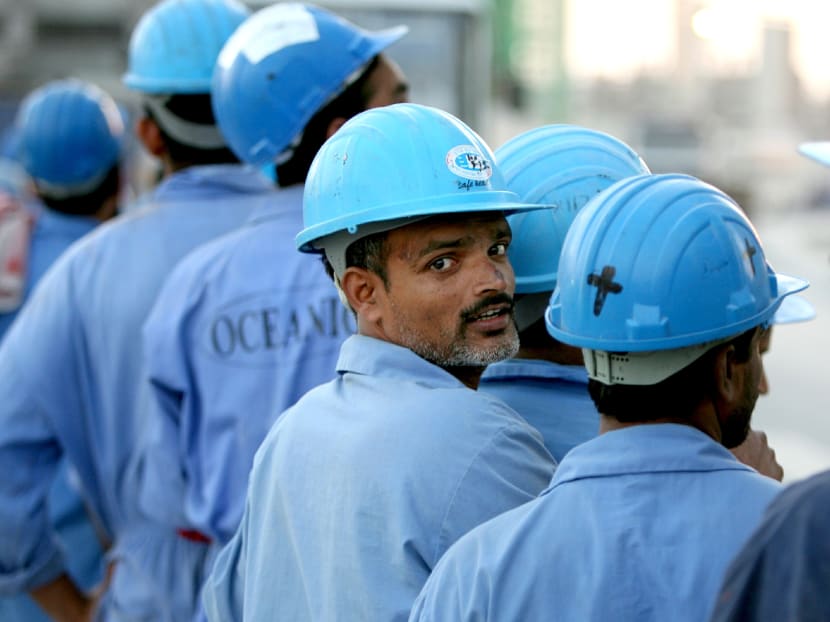Gulf woes resound across south Asia as worker remittances drop
COCHIN — For 16 years, Mr Jobby Peter has supported his family back home in India by working in the bustling, oil-driven economies of the Gulf. In his most recent job, the 41-year-old welder was earning nearly US$500 (S$695) a month fabricating oil tanks in Dubai’s Jebel Ali Free Zone.

Indian workers line up to board a bus after a day's work in Dubai, November 18, 2005. Photo: Reuters
COCHIN — For 16 years, Mr Jobby Peter has supported his family back home in India by working in the bustling, oil-driven economies of the Gulf. In his most recent job, the 41-year-old welder was earning nearly US$500 (S$695) a month fabricating oil tanks in Dubai’s Jebel Ali Free Zone.
But four months ago, he abruptly found himself unemployed when he and 40 co-workers, all from south Asia, were told their services were no longer required. Low oil prices had hit orders, and the fabrication unit was being shut down.
“They told us, ‘All of you have to go back because we have no demand any more,’” said Mr Peter, who was given three months’ salary and a ticket back to India.
Today, he is working occasionally in a Cochin shipyard while trying to get back to the Gulf. One recent Saturday, he was among nearly 1,000 people queueing for interviews with construction companies recruiting skilled workers for a clutch of welding jobs in the region. “I am trying,” he said. “I am hopeful.”
But Mr Peter’s hopes may be misplaced. For nearly two decades, millions of workers from India and other south Asian countries, including Nepal, Bangladesh and Pakistan, have looked to the oil-driven economies of the Gulf Co-operation Council for jobs and salaries that are unavailable at home. But low global oil prices and cash-strapped Gulf countries’ efforts to find employment opportunities for their own citizens, are reversing that tide.
Construction work has been hit by a severe liquidity squeeze, leading to lay-offs of foreign workers, some of whom have been left stranded in the desert by their former employers. Meanwhile, service industry jobs previously undertaken by foreign workers, such as positions as shop assistants and mobile phone repair technicians, have been reserved for locals as Gulf economies pare their social welfare schemes.
For foreign workers who still have jobs, wages are also under pressure as employers attempt to freeze salaries and recruitment agencies look to poorer countries to hire workers.
“Wages in the Gulf will come down,” said Mr S Irudaya Rajan, a migration expert at Trivandurum’s Centre for Development Studies. “They will replace people with those that are willing to work for less, and that is where you will find remittances coming down.”
Migrant workers’ remittances to south Asia fell 6.4 per cent last year after years of steady increases. Remittances to India slumped 8.9 per cent in 2016 – the second consecutive year of decline – to US$62.7 billion, down from US$72 billion two years earlier.
Although remittances account for just 2.8 per cent of India’s gross domestic product (GDP), the decline is a blow to the southern state of Kerala, where they make up 36 per cent of the local economy.
“There is no household that doesn’t have some direct or indirect relationship to migrant workers in the Gulf,” said Mr Shashi Tharoor, a member of the national parliament from Kerala.
“Without this kind of money coming in, a lot of people’s lives are going to be seriously affected. We are going to be facing a very serious crisis if this trend continues.”
Other south Asian countries have also been hard hit. In Bangladesh, remittances, which account for 6 per cent of its GDP, dropped 11 per cent in 2016. In Nepal, such earnings constitute 30 per cent of GDP, but they fell 6.7 per cent in 2016 – albeit after unusually high growth of 14.5 per cent in 2015, when a devastating earthquake struck the country and relatives sent even more money home in an attempt to help. Pakistan’s remittances rose a robust 12 per cent in 2015, but growth moderated to 2.8 per cent in 2016.
Some analysts believe that remittances to south Asia will recover slightly in the coming year. But Mr Krishnan Sreenivasan, who runs a recruiting agency in Cochin, believes south Asia’s remittance economy has peaked, with the oil industry that fuelled the Gulf boom in long-term decline.
“The charm is over,” he noted. “You can’t expect long-term growth. I don’t see much prospect for the oil industry in the long run. Remittances will continue to fall.”
But south Asian dreams of achieving prosperity by working in the Gulf will not fade easily. Mr Mahsur, a 37-year-old accountant, was earning more than US$2,100 a month at an insurance company in Abu Dhabi until he was recently told to take a “long leave” as the economy slowed. Back in Kerala, he plans to return to the Gulf to hunt for another job rather than seek work at home.
“Kerala is addicted to remittances,” said Mr Rajan. “Even if they don’t get any job, they will stand there, they will wait there and they will look for any job. They don’t even mind working for a lower wage – because they think it gives them a social status which you can’t get working in Kerala.” FINANCIAL TIMES





